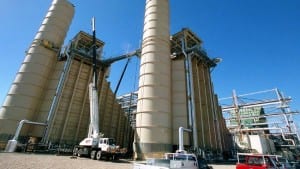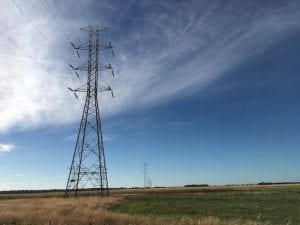The three biggest solar farms in New South Wales will face “material” constraints to their output when they join the grid west of Wagga Wagga over the next 12 months, as do another half a dozen existing and soon-to-be connected solar farms in the region.
In yet another indication of the complete shambles that has been network planning and market rules in Australia’s main grid over the past decade, a new analysis of network capacity in the south-west region by Transgrid, the state’s transmission owner, says the local network cannot support the number of new solar farms in the area without significant upgrades to network capacity.
The problem area is the network west of Wagga Wagga (see map at bottom of story). The fear is that too much power will flow back east because of a lack of demand where the solar farms are located.
Therefore, it says, to reduce the risk of “voltage collapse” if too much electricity flows east at the wrong time, a new limit will be imposed. That limit for power flowing east is expected to be set at 300MW. But power flows east are already peaking at 200MW from existing generators, and another 724MW of large scale solar capacity is due to be commissioned in coming months, with more to follow next year.
“This will result in material constraints to some generators in the region,” Transgrid says in the document. It won’t say which ones will be affected, apart from saying this will be decided by the market operator’s dispatch system.
But those at risk are the big new installations in the area are the new 275MW Darlington Point solar farm (soon to be registered, and owned by Edify and Octopus), the newly registered 220MW Limondale 1 solar farm (owned by Germany’s Innogy),), and the mechanically complete but not yet registered and already delayed 200MW Sunraysia solar farm (John Laing and Maoneng).
They will rank as the three biggest solar projects in the state, once operating, but will unlikely be allowed to operate at full capacity at the same time.
Other new projects due to join the grid in the area include the smaller but already operating 29MW Limondale 2 solar farm, while the 85MW Hillston solar farm, and the 30MW Riverina solar farm are both due for commissioning in 2021. Another 475MW projects have submitted connection applications to be considered over the next few years.
Existing solar farms in the area include the 150MW Colleambally (Neoen), the 133MW Finley (John Laing), the 33MW Griffith (Neoen) and the 52MW Broken Hill (owned by PARF, pictured above) solar farms, and the 200MW Silverton wind farm (PARF) near Broken Hill could also be affected.
Happily for Transgrid major shareholder Spark Infrastructure, its newly commissioned 100MW Bomen solar farm will not be affected because it is located on the east side of Wagga Wagga. It announced today the new project is operating at full capacity.
It is not clear how the constraints would be imposed on the plants operating in the area. The market notice issued by AEMO does not make this clear, although it suggests the constraint could also impact solar farms in north-west Victoria, which only recently emerged from a 7-month restriction on 50 per cent of their output caused by separate voltage issues.
The problem identified by Transgrid is the risk of “voltage collapse” should one of the main lines in the region (line 63, see map at bottom of story) fails. It notes that this is a rare event. “Historical fault rates are low,” it notes. But to mitigate the risk of wider consequences of a voltage collapse should line 63 fail, the 300MW constraints on power flowing east could be applied at all times.
Transgrid suggests four options to solve the problem, and these include a bunch of additional network spending. The three network additions or upgrade options put forward will cost between $145 and $340 million, which Transgrid argues will deliver “clear market” benefits because of the amount of output that would be lost otherwise.
The installation of a piece of machinery known as a “statcom” may only cost $30-$50 million, but would not solve all the problems or relieve all the constraints. Transgrid says synchronous condensers “do not respond fast enough” to deal with this particular issue, and any battery storage solution would need to be accompanied by a statcom in any case, meaning it would not be commercially viable.
 However, Transgrid says it is open to any proposals that could use big batteries as part of a System Integrity Protection Scheme – measures currently employed to alleviate pressure on links between Victoria and South Australia, and which may include a new 600MW Victoria big battery to improve the capacity of the main link between Victoria and NSW.
However, Transgrid says it is open to any proposals that could use big batteries as part of a System Integrity Protection Scheme – measures currently employed to alleviate pressure on links between Victoria and South Australia, and which may include a new 600MW Victoria big battery to improve the capacity of the main link between Victoria and NSW.
Because of Australia’s laboriously slow regulatory process, the multi-stage regulatory investment test, the earliest that any of these options could be delivered would be 2024/25.
In the meantime, the constraints on output from the state’s biggest solar farms will not just affect the pace of the state’s and the country’s energy transition, but also the price forecasts for wholesale electricity and large scale generation certificates, and it may add to the growing list of problems that could make some big international companies wonder if investing in Australia is worth the effort.
This constraint is just the latest in a series of actions imposed by network owners and the market operators as a result of new modelling that highlights the lack of network infrastructure in some regions to deal with the huge number of wind and solar plants.
AEMO is seeking to address this problem through its much admired Integrated System Plan, a 20-year blueprint that maps out what is needed to accommodate between 70 and 94 per cent renewables by 2040.
Its focus is on the need for new transmission links, network upgrades, and the creation of renewable energy zones, including in the south-west region of NSW, but all that will happen too slowly to relieve the short term impacts on existing and already committed wind and solar projects.
The number of constraints on output is growing rapidly. South Australia is limited to around 1800MW of large scale wind, although that may soon be relived by the addition of new synchronous condensers, a sort of spinning machine that doesn’t burn fuel but provides the “synchronous” capacity deemed necessary by the networks and AEMO.
System strength shortfalls have also been identified in Victoria, south west NSW, north Queensland and even in Tasmania. Three wind and solar farms in north Queensland have not been switched on for nearly three weeks, nine others have been warned of being switched off in the “rare event’ that more coal generators go offline for maintenance at the same time as low demand, while the addition of another two wind farms in Tasmania.
The options for the affected solar farms in NSW are not great. They could add a big battery to create additional local “load”, and so reduce the amount of power flowing east.
But one problem is that under the rules of Australia’s energy market, any benefit on constraints from that battery would be shared among all the solar farms, not just the owner, developers says. So, let’s say a 200MW solar farm adds a 100MW battery. It might expect to be allowed to generate 100MW more because it will go into the battery cells it has installed. But no, the 100MW credit from the battery load is shared amongst all.
It’s one of a number of rules in the market that, quite simply, beggar belief. No wonder the rules of the market are being re-written by the Energy Security Board. But even if agreed, and if the federal government agrees to let the ESB do this, the rules won’t come into effect until 2025.
People may ask why, for instance, were so many solar farms allowed to be built in the areas?
The main reason is because that’s where the best resource is. But wind and solar developers in Australia, until very recently, were not told by the network owners if there were any competing projects. Until very recently, the market rules crazily prevented the networks from doing so – even if the networks knew it was a bad idea and a bunch of new projects were being built right on top of each other.
Why, then, you may ask, didn’t the networks plan for more network capacity before this? Particularly as the cost of the upgrade to mitigate this problem is not huge, compared to the amount of investment in new capacity.
The answer lies in the way the regulations work: You need to argue for a clear market benefit. And even that argument is narrowed only to wholesale market prices, such as from lower or avoided fuel costs – and the benefits to the end user barely feature.
And the regulations, of course, don’t consider environmental or climate benefits, or the broader transition. For this reason, there is genuine fear that the regulator may have no choice but to knock the proposed new link from South Australia to NSW – Project EnergyConnect – on its head.
As one exasperated solar developer noted: “It’s just the way it works in Australia. Everyone builds where the resource is. We’ve got this RiT-T (regulatory investment test) designed to stop gold plating, but it stops investment completely. Our system is designed so that nothing can change unless there is a market shock. You wait until there is an extreme problem until you do something about it.”













